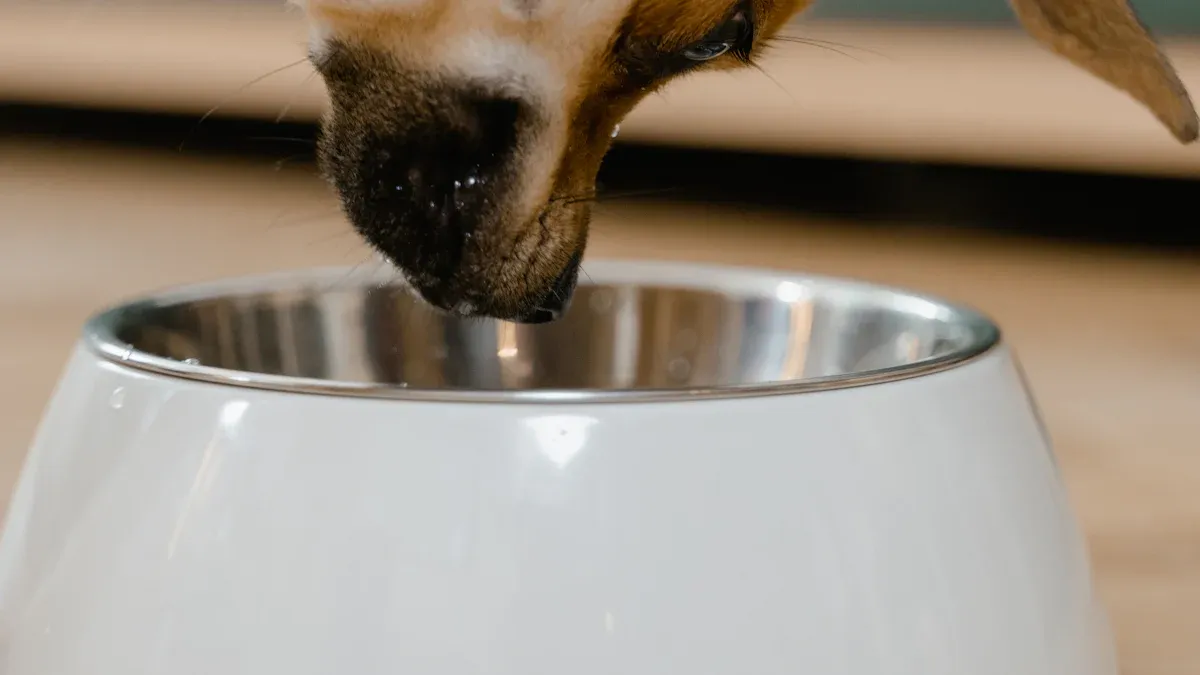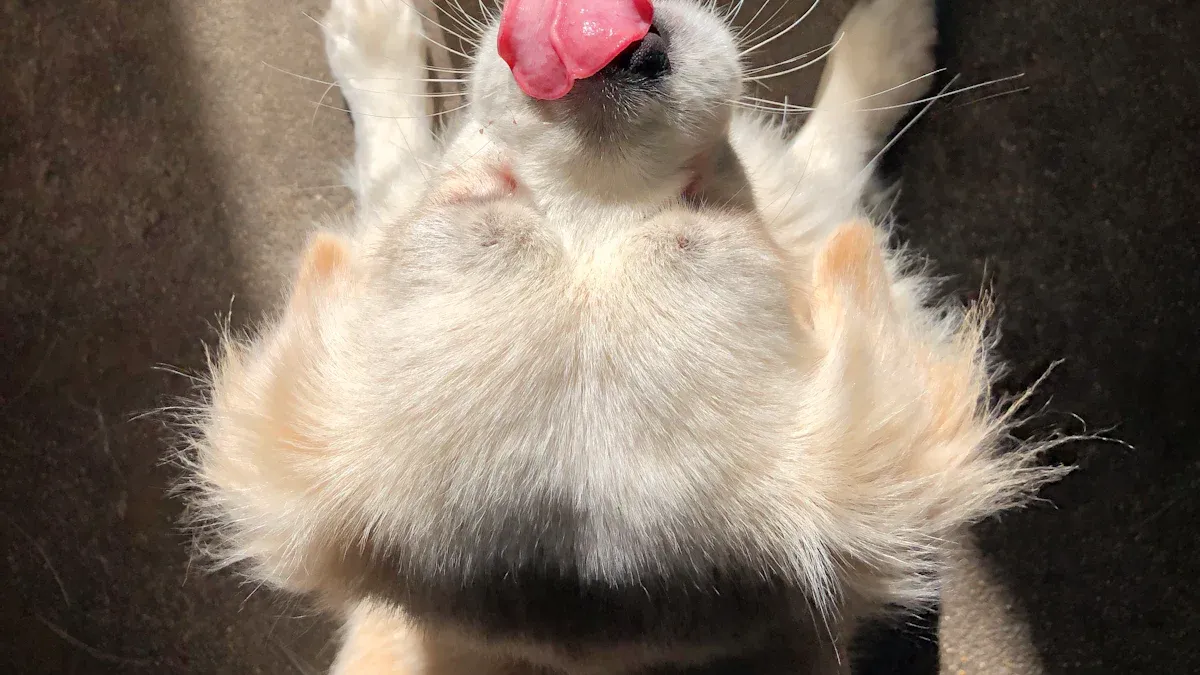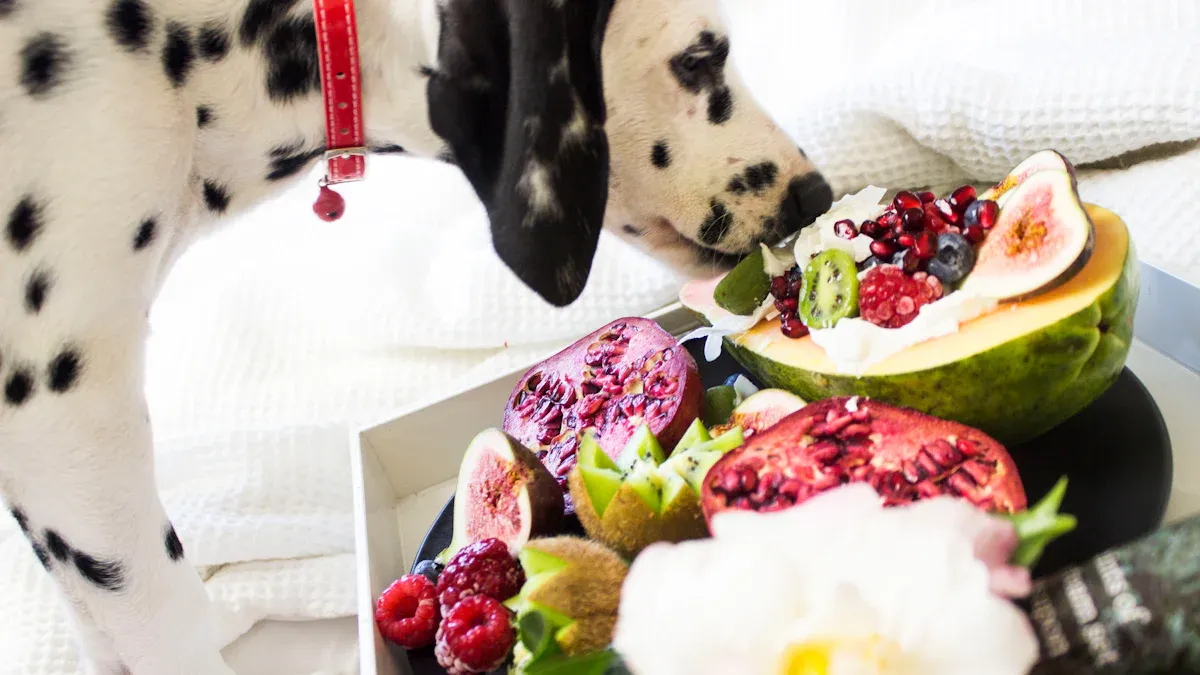
Your dog’s health depends on what they eat daily, making Dog Food & Nutrition a crucial aspect of their well-being. Giving them a balanced diet keeps them happy and active. It also boosts their immune system and overall health. Research shows dogs eating whole foods have stronger immunity. They have better body responses, like lower harmful ratios and higher good ones. A good diet also helps your dog stay fit and live longer. Choosing food your dog enjoys is essential for their growth and health, highlighting the importance of understanding Dog Food & Nutrition.
Key Takeaways
A good diet is very important for your dog’s health. It helps them stay happy, active, and strong.
Proteins, fats, and carbs are key nutrients. Pick dog food with real meat, good fats, and healthy carbs for energy.
Always check dog food labels. Find foods with good ingredients and skip fillers or bad additives.
Keep your dog hydrated! Give fresh water every day and try wet food to add more water.
Ask your vet for advice about your dog’s food. They can suggest the best food for your dog’s age, size, and health.
Key Nutritional Needs for Dogs
Proteins
Why proteins are important for dogs
Proteins help build and repair your dog’s body. They keep muscles strong and coats shiny. Foods like chicken, beef, and fish give important amino acids. These nutrients help your dog grow and stay healthy. Studies say enough protein keeps active dogs lean and fit.
Common protein choices in dog food
Pick dog food with good protein levels. Usual sources are poultry, lamb, and plant-based options like peas. These give energy and keep your dog healthy. Always check the label to see if protein is the first ingredient.
Fats
How fats help your dog
Fats give your dog lots of energy. They also help absorb vitamins like A, D, E, and K. Omega-3 and omega-6 fats make skin and fur better. They also lower swelling. Healthy fats are key for your dog’s diet.
Where to find omega-3 and omega-6 fats
Omega-3 fats are in fish oil and flaxseed. Omega-6 fats come from chicken fat and sunflower oil. These fats help heal wounds and improve joints. Many dog foods include these fats for better health.
Carbohydrates
Why carbs are good for energy
Carbs give your dog energy to play all day. Complex carbs, like oats and sweet potatoes, release energy slowly. This keeps your dog active longer. Studies show carbs affect energy and digestion.
Dog-friendly carb options
Choose dog food with carbs like brown rice, barley, and peas. These are easy to digest and give steady energy. Avoid foods with too many fillers. Fillers don’t add useful nutrients for your dog.
Vitamins & Minerals
Important vitamins for a healthy diet
Vitamins are needed to keep your dog healthy. They help with energy and a strong immune system. For example, Vitamin B1 (Thiamin) supports the heart and nerves. Vitamin B6 (Pyridoxine) stops anemia and kidney problems. Below is a table of key vitamins and their benefits:
Vitamin/Mineral | Problems from Lack of Vitamin | |
|---|---|---|
Thiamin (B1) | 1 mg/kg DM | Heart issues, poor appetite, seizures |
Riboflavin (B2) | 2.2 mg/kg DM | Slow growth, weight loss, nerve problems |
Pyridoxine (B6) | 1 mg/kg | Anemia, seizures, kidney problems |
Niacin (B3) | 11.4 mg/kg DM | Skin issues, diarrhea, slow growth, possible death |
Pantothenic Acid (B5) | 10 mg/kg DM | Weight loss, weak immune system |
Cobalamin (B12) | 0.022 mg/kg | Anemia, poor growth, nerve problems |
Adding these vitamins keeps your dog active and healthy. Check dog food labels to ensure they meet these needs.
Minerals like calcium and phosphorus
Minerals such as calcium and phosphorus are also important. Calcium makes bones and teeth strong. Phosphorus helps repair cells and store energy. Without these, dogs may have weak bones or poor coats. Foods with balanced minerals keep dogs strong and healthy.
Water
Why water matters in dog nutrition
Water is often ignored but very important. It helps control body temperature and aids digestion. Water also keeps joints working well. Without enough water, dogs can get dehydrated, which is dangerous.
How to keep your dog hydrated
Give fresh, clean water every day.
Watch how much water your dog drinks.
Add wet food to their meals for extra water.
Talk to your vet if you’re worried about hydration.
Keeping your dog hydrated is easy and very important. A hydrated dog is a happy and healthy dog!
Types of Dog Food

Dry Food
Why kibble is easy and good for teeth
Kibble, or dry food, is a favorite for dog owners. It’s simple to store and serve, perfect for busy families. Chewing kibble helps clean teeth and lowers plaque. Research shows 81% of owners use kibble, and dogs eating it are often healthier than others.
Picking the best dry food
Not all kibble is the same. Choose dry food with a label showing it meets nutrition standards. Good kibble lists proteins like chicken or lamb first. Stay away from foods with fillers or fake additives. Reading labels helps you find the healthiest choice for your dog.
Wet Food
Why wet food helps with water and taste
Wet food is great if your dog needs more water or likes tastier meals. Its high water content keeps dogs hydrated, especially those who don’t drink much. Wet food also has more meat, making it yummier. Here’s a quick comparison:
Aspect | Wet Food | Dry Food |
|---|---|---|
Moisture Content | More water, good for hydration | Less water |
Palatability | Tastier with more meat | Less tasty, more carbs |
How to pick good canned food
Pick wet food with clear ingredients and a nutrition label. Look for high protein and avoid too much salt or fake preservatives. Wet food can be a delicious and healthy part of your dog’s meals.
Raw Diets
What raw feeding is and its benefits
Raw diets are becoming more popular for dogs. Supporters say raw food gives shinier fur, better skin, cleaner teeth, and smaller poop. Dogs on raw diets might also have more energy. But it’s important to balance nutrients to avoid problems.
Dangers of raw diets and staying safe
Raw diets can be risky. Raw meat may have bacteria that harm dogs and people. An unbalanced diet can cause weak bones or bad fur. Experts like Dr. Lisa M. Freeman warn about nutrient issues, and FDA studies show raw food often has bacteria. Talk to your vet before trying raw food to keep your dog safe and healthy.
Homemade Options
Why making meals at home is great
Cooking for your dog lets you control their food completely. You can pick fresh, good-quality ingredients and skip harmful stuff. This makes sure your dog gets the best nutrition for their needs. Homemade meals also let you change portions and ingredients. Adjust them based on your dog’s age, size, or health.
Another bonus? You can match your dog’s favorite flavors. If they dislike store-bought food, homemade meals might work better. Cooking for your dog also builds a stronger bond. It’s a fun way to care for them while keeping them healthy and happy.
Steps for balanced homemade dog food
Balanced meals are very important for dogs. They need proteins, healthy fats, carbs, vitamins, and minerals. Start with a good protein like chicken, turkey, or fish. Add carbs like brown rice or sweet potatoes for energy. Include veggies like carrots or spinach for extra nutrients.
Here are some helpful tips:
Talk to your vet: Always ask your vet before switching to homemade food. They can help you plan meals that fit your dog’s needs.
Add supplements: Homemade food might miss some vitamins or minerals. Use supplements like calcium or fish oil to fill the gaps.
Avoid dangerous foods: Don’t use onions, garlic, chocolate, or grapes. These are toxic for dogs.
If you’re not sure how to start, follow a vet-approved recipe. This way, your dog’s meals will be tasty and healthy.
How to Choose the Right Dog Food
Reading Labels
Understanding ingredient lists and nutritional information
Checking pet food labels helps you pick good food. Ingredients are listed by weight, so the first ones are the main parts. Look for real meats like chicken or beef at the top. The guaranteed analysis section shows protein and fat levels. This helps you see if the food fits your dog’s needs. Also, find a nutritional adequacy statement. This tells you if the food meets standards for balanced nutrition, like for growth or adult dogs.
Identifying high-quality ingredients in pet food
Good pet food uses real, whole ingredients. Look for specific proteins like “chicken” instead of unclear terms like “meat by-products.” Whole grains, veggies, and healthy fats are signs of quality. Stay away from foods with fake colors, flavors, or preservatives. A tip: If the ingredient list has hard-to-read words, it might not be the best choice.
Avoiding Harmful Ingredients
Common additives and fillers to avoid
Some pet foods have fillers and additives that aren’t healthy. Things like corn syrup, fake dyes, and chemical preservatives can harm your dog over time. Fillers like wheat gluten or soy protein might cause allergies or tummy troubles. Picking food without these bad ingredients keeps your dog healthier.
Recognizing signs of low-quality food
Bad pet food often has unclear labels, too many fillers, and fake additives. If the first ingredient isn’t a clear protein or there are lots of by-products, it’s a warning sign. Studies show dogs on balanced diets, even plant-based ones, stay healthy. This proves why avoiding bad ingredients and choosing quality food is important.
Considering Your Dog’s Age, Size, and Health
Nutritional needs for puppies, adults, and seniors
Dogs need different food at different ages. Puppies need more calories and nutrients to grow. Adult dogs need food for maintenance, like adult formulas. Older dogs need fewer calories and extra joint support. Always pick food made for your dog’s age to give them the right nutrients.
Adjusting food for breed size and health conditions
Your dog’s size and health affect their diet. Big dogs may need food with joint support. Small dogs might prefer smaller kibble pieces. Dogs with issues like obesity or allergies may need special diets. Research shows body size and health affect aging and disease. Feeding the right food helps manage these and keeps your dog well.
Tips for Transitioning to Healthy Food
Gradual Changes
Importance of slowly introducing new food
Switching your dog’s food too quickly can upset their stomach. A gradual transition helps their digestive system adjust to the new ingredients. This reduces the risk of issues like diarrhea or vomiting. Slow changes also give your dog time to get used to the new taste and texture, making the process smoother for both of you.
Step-by-step guide to transitioning
Follow these steps to make the switch easier:
Days 4-6: Mix 50% of the new food with 50% of the old food.
Days 7-9: Mix 75% of the new food with 25% of the old food.
Day 10: Feed 100% of the new food.
During this time, keep an eye on your dog’s reaction. If you notice any digestive issues, slow down the process. Patience is key to ensuring a smooth transition.
Monitoring Your Dog’s Reaction
Signs of food intolerance or allergies
Pay close attention to how your dog reacts to the new food. Common signs of intolerance or allergies include:
Itchy skin or excessive scratching
Chronic flatulence or a rumbly stomach
If you notice any of these symptoms, your dog might not tolerate the new food well.
Adjusting the diet based on your dog’s response
If your dog shows signs of discomfort, don’t panic. Go back to their old food for a few days, then try reintroducing the new food more slowly. You can also experiment with different brands or formulas to find one that suits them better. Always prioritize their comfort and health during this process.
Consulting a Vet
Importance of professional guidance
Your vet is your best resource when it comes to your dog’s nutrition. They can recommend the right food based on your dog’s age, size, and health. Vets also help you avoid common pitfalls, like unbalanced diets or harmful ingredients. Their advice ensures your dog gets the nutrients they need for long-term health.
Questions to ask your veterinarian
When consulting your vet, consider asking:
What type of food is best for my dog’s specific needs?
Are there any supplements I should add to their diet?
How can I tell if the new food is working for my dog?
These questions help you make informed decisions and ensure your dog’s diet supports their overall well-being.
Healthy Treat Options

Store-Bought vs. Homemade Treats
Pros and cons of store-bought treats
Store-bought treats are easy to get and use. You can buy them online or at stores, and they’re ready to eat. Many brands make treats for special diets, like low-calorie ones for weight control. They also last a long time, so you don’t need to worry about them going bad quickly.
But not all store-bought treats are the same. Some have preservatives or additives you might not want. You also can’t control the ingredients, which is a problem if your dog has allergies. Plus, buying them often can get expensive.
Here’s a simple comparison to help you choose:
Type of Treat | Pros | Cons |
|---|---|---|
Store-bought | – Easy to find and use | – Might have preservatives or additives |
– Lots of options available | – Less control over what’s inside | |
– Made for specific dietary needs | – Can cost more over time | |
– Lasts longer | – May not fit all dietary needs | |
Homemade | – You control all ingredients | – Takes time to make |
– Can match your dog’s needs | – Doesn’t last as long | |
– Fun to make with your dog | – Results depend on recipe and prep | |
– Healthier with fresh ingredients | – Requires safe food handling knowledge |
Benefits of making treats at home
Making treats at home lets you pick the best ingredients. You can use fresh, healthy foods and skip anything harmful. It’s also great for dogs with allergies or picky tastes since you can customize the recipe.
Homemade treats are also a fun activity for you and your family. It’s a chance to spend time with your dog while giving them healthy snacks. Just remember, homemade treats don’t last as long as store-bought ones, so make small amounts to keep them fresh.
Ingredients to Look For
Nutrient-rich ingredients for healthy treats
Choose treats with ingredients that are good for your dog. Look for ones that meet AAFCO nutrient standards, as these help keep dogs healthy. Foods like lean meats, sweet potatoes, and blueberries are great choices. They give important vitamins and minerals while helping your dog stay at a healthy weight.
Here’s how healthy treats can help your dog:
Nutrient Profile | Health Outcome |
|---|---|
Meets AAFCO nutrient standards | Helps maintain overall health |
Keeps body weight steady | Shows positive health effects |
Lowers body fat with plant-based options | Improves health results |
Avoiding harmful additives in treats
Some treats have bad ingredients like fake colors, flavors, or preservatives. These can harm your dog over time. Avoid treats with hard-to-read or strange-sounding ingredients. Instead, pick natural treats made with simple, whole foods.
For example, dogs eating raw commercial diets are more likely to get breathing problems. Home-cooked diets can also cause liver or kidney issues if not done right. Always check labels or ask your vet if you’re unsure.
Your dog’s health depends on good dog food & nutrition. Eating balanced meals keeps them happy and full of energy. It can even help them live longer. Research shows lean dogs may live nearly 2 years more. Healthy meals with omega-3s and antioxidants can prevent diseases. They also improve your dog’s overall health.
🐾 Tip: Talk to your vet to create the best diet for your dog.
Choosing high-quality dog food & nutrition helps your dog stay healthy and enjoy life.
FAQ
What is the best food for your pet?
The best food depends on your pet’s age, size, and health. Choose high-quality food with balanced nutrients. Check labels for real meat and avoid bad additives. Ask your vet to help pick the right food for your pet.
How can you tell if your dog’s food meets their nutrition needs?
Look for a nutritional adequacy statement on the label. This shows the food meets balanced nutrition standards. Pick food with real meat, healthy fats, and good carbs. If unsure, ask your vet for advice.
Are there nutrition resources to help you choose dog food?
Yes, many websites and blogs give helpful dog food tips. Sites like AAFCO or vet blogs share trusted advice. Your vet can also help make a diet plan for your dog.
How often should you change your dog’s food?
Only change food when needed, like for age or health reasons. Switch slowly to avoid stomach problems. If unsure, ask your vet for help.
Can homemade meals replace store-bought dog food?
Homemade meals are fine if they’re balanced and healthy. Use fresh foods and add supplements if needed. Avoid harmful foods like chocolate or onions. Always check with your vet before making homemade meals.
